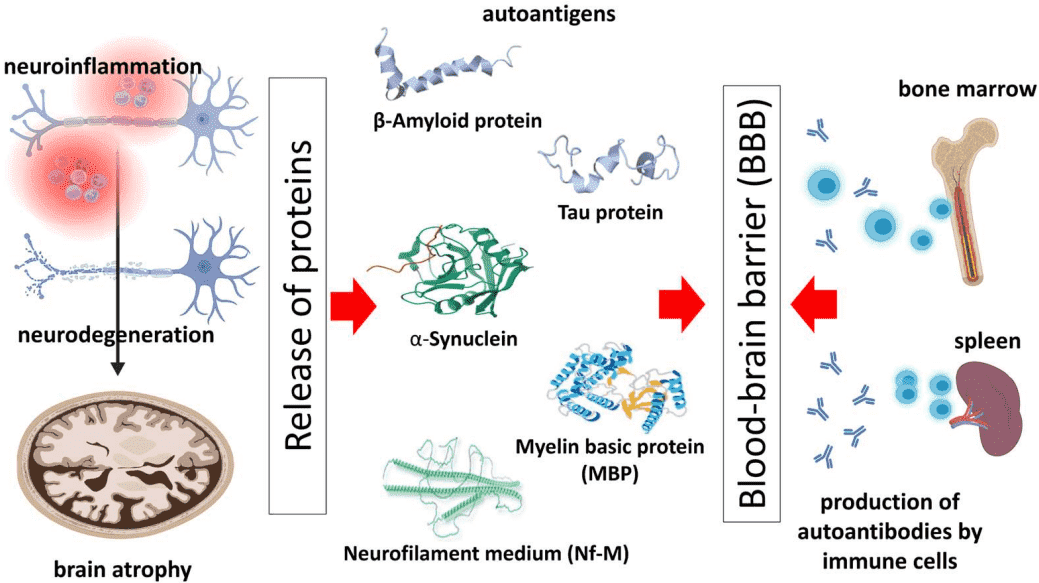NAA and Neurological Diseases
Antibodies directed against self-antigens have been observed in a variety of neurological diseases, they can be used as biomarkers of these diseases. Therefore, autoimmune neurology has seen a huge development in recent years. Creative Biolabs is a leading provider of NAA testing and analysis services. We have a team of experienced professionals and an advanced technology platform to provide a full range of NAA services and products for neurological diseases.
Overview of Neurological Diseases
Neurological diseases are defined medically as those that affect the brain as well as nerves and spinal cord throughout the body. Structural, biochemical, or electrical abnormalities of the brain, spinal cord, or other nerves can cause a range of symptoms. Antibody-associated neurological disorders are characterized by a variety of clinical symptoms, including memory impairment, psychosis, behavioral abnormalities, motor disorders, epilepsy, or vegetative dysfunction. Traditionally, antibodies in neurological diseases were referred to as malignancy-associated onconeuronal antibodies, that is, those binding to nuclear or cytoplasmic proteins such as Hu, Ma, and Yo. These neurological disorders are mediated mainly by cytotoxic T cells.
- NAA and Schizophrenia
- Alzheimer Disease
- Lambert-Eaton Muscular Weakness Syndrome
- Amyotrophic Lateral Sclerosis
- NAA and Epilepsy
Schizophrenia is a complex, debilitating neuropsychiatric condition that is believed to be caused by various genetic and neurodevelopmental abnormalities. It is characterized by hearing-speech hallucinations due to altered information flow between auditory and language-processing related areas. Schizophrenia is associated with immune system dysfunction, including an increased incidence of autoimmune diseases and autoantibodies.
Alzheimer's disease (AD) is the most common type of dementia. AD is a neurodegenerative disease with insidious onset and progressive impairment of behavioral and cognitive functions including memory, comprehension, language, attention, reasoning, and judgment. The neuropathological features of AD include "positive" lesions such as amyloid plaques and amyloid vasculopathy in the brain, neurofibrillary tangles and glial responses, and "negative" lesions such as neuron and synaptic loss. The autoantibodies specific to distinct molecular antigens are present in sera or cerebrospinal fluids from patients with AD. They could have a protective (i.e., anti-β-amyloid) or a pathogenetic role (i.e., anti-GM1 or anti-ATP synthase) but, in any case, they might be considered as useful diagnostic or prognostic markers of the disease.
Lambert-Eaton myasthenic syndrome (LEMS) is an idiopathic or paraneoplastic syndrome that produces antibodies against presynaptic volt-gated P/Q calcium channels. This reduces the entry of calcium ions into the presynaptic terminal, preventing the binding of vesicles to the presynaptic membrane and the release of acetylcholine. LEMS represents one of the distinct autoimmune disorders at the neuromuscular junction. Diagnosis of LEMS is based on clinical signs and symptoms, electrophysiological studies, and antibody tests.
Amyotrophic lateral sclerosis (ALS) is an idiopathic and fatal neurodegenerative disease of the human motor system. Activation of the immune system was observed during neurodegeneration, and heterogeneous patient populations co-existed. Identifying specific biomarkers might allow subgrouping of ALS patients, early diagnosis, and effective intervention.
Epileptic seizures are one of the most commonly experienced neurological symptoms affecting almost 1% of the world population. It is characterized by recurrent episodes associated with characteristic signs and/or symptoms of abnormal, excessive, or synchronized neuronal activity caused by persistent brain dysfunction. In recent years, the detection of autoantibodies has contributed to the etiologic understanding of a substantial number of so far unexplained epilepsies.
Autoantibodies in Neurological Diseases
Antibodies have been observed in a variety of neurological disorders. Target antigens encompass structural intracellular and transmembrane proteins, ion channels, neurotransmitter receptors, intracellular enzymes, glycolipids, and carbohydrate epitopes shared by different proteins. Autoantibody-associated neurological disorders (AAND) can affect each structure along the neuraxis from the cortex, white matter, spinal cord, and nerve roots to the terminal neuromuscular junction and muscle, and present with characteristic localization-dependent clinical syndromes.
 Fig.1 Possible mechanisms of autoimmune response to pathology-related molecules of the most common neurodegenerative diseases.1
Fig.1 Possible mechanisms of autoimmune response to pathology-related molecules of the most common neurodegenerative diseases.1
Creative Biolabs offers well-established and innovative One-Stop-Shop NAA solutions. We can apply our considerable experience with NAA testing to develop the necessary analytics specific to your project. If you are interested in our services and products, please contact us for more detail.
Reference
- Miteva, Dimitrina, Georgi V. Vasilev, and Tsvetelina Velikova. "Role of Specific Autoantibodies in Neurodegenerative Diseases: Pathogenic Antibodies or Promising Biomarkers for Diagnosis." Antibodies 12.4 (2023): 81.
Choosing natural autoantibody (NAA) microarray to profile autoantibody repertoire and reveal novel disease's marker.
- NAA and Schizophrenia
- NAA and Alzheimer's Disease
- NAA and Lambert-Eaton Muscular Weakness Syndrome
- NAA and Amyotrophic Lateral Sclerosis
- NAA and Epilepsy
Related Services:
- NAA and Cancers
- NAA and Pulmonary Diseases
- NAA and Nephropathy
- NAA and Hematological Diseases
- NAA and Endocrine Diseases
- NAA and Cardiovascular Diseases
- NAA and Infectious Diseases
- NAA and Autoimmune Disorders

